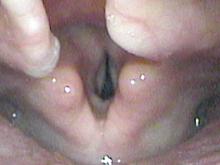When the vocal cords do not come together as they should, air leaks. We could call this, “husky hoarseness.” To understand “husky hoarseness,” it is helpful to think of one of the extreme types of sound production we can make with our larynx: extremely soft sound. We can generate sound in the larynx with the vocal cords in a partially or even completely open position - that sound is called a whisper.
In a whisper, the vocal cords do not vibrate. The airflow is increased as it passes the narrowest spot; generally that spot is the vocal cords and turbulence is created. Airflow that is turbulent consists of many different pitches simultaneously; white noise.
This signal, generated by white noise, lacks intensity and cannot be heard well or from very far away. It is not very penetrating. White noise blends with environmental noise. For example, open the windows in a car while travelling and a great deal of turbulent airflow is created at the window. This white noise effectively mutes other sounds. A whisper in a car, which is also white noise, blends in with the sound created by the open windows and cannot be heard at all.
Conversely, we produce voice at a single pitch to generate a strong signal that will stand out against background noise. This is a signal that we modify with vowels and consonants to carry information from one human to the next. With a clear tone we can generate sounds that are distinct and carry well, even in a convertible on the highway, driving with the top down.
The stage whisper brings the vocal cords close enough together that they start to vibrate a little, so a stage whisper is really a mixture of a lot of whisper and a little bit of a pitch.
In between a whisper (cords apart) and a clear tone (cords completely together), we can have some mix of a pure tone and white noise. The white noise gives the voice a husky quality. Sometimes this huskiness is not desired, as when the swelling of the vocal cords from laryngitis allows air to leak out. Other times, for example, a nightclub singer might wish to add a component of breathiness. She is adding an intentional gap between the vocal cords to let some air leak out. A novice singer may be straining so hard to accomplish a breathy voice that she ends up tensing multiple muscles in the larynx and inadvertently holds the vocal cords apart.
So, while a whisper is the extreme of turbulent airflow at the vocal cords, any gap between the vocal cords will add a commensurate degree of huskiness to the voice.


